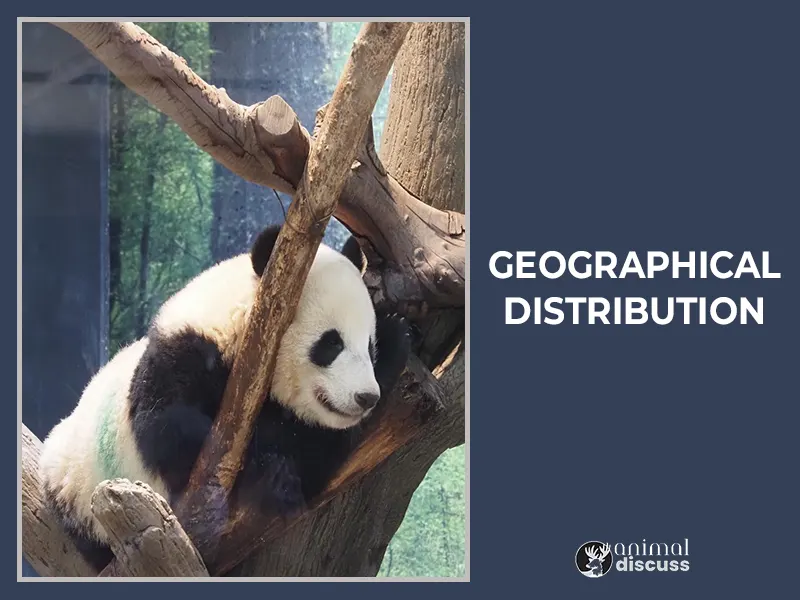Giant pandas, scientifically known as Ailuropoda melanoleuca, stand out in the animal realm due to their iconic black and white fur and a diet predominantly focused on bamboo.
Exclusive to China, these creatures are revered as a national treasure and a symbol representing harmony. Despite their fame, giant pandas face severe endangerment, with only slightly over 1,800 existing in the wild.
Characterized as the rarest bear family members, giant pandas stand out with their considerable size, reaching over four feet in height and weighing between 220 to 330 pounds.

Their distinctively large heads, compared to other bears, are an evolutionary adaptation to their bamboo-centric diet—a sturdy and resilient plant.
Despite their ecological importance, their small population, lengthy generation span, and slow reproduction rate constrain their ability to adapt to environmental shifts.
Understanding the influence of habitat on these pandas becomes pivotal in safeguarding their existence and ensuring their preservation.
Geographical Distribution
While a few small wild populations exist in neighboring nations, over 98% of all wild pandas are in these key mountainous habitat reserves solely in China.
This means that the wild giant pandas are currently found only in three provinces in China: Sichuan, Shaanxi, and Gansu. About 75% of wild pandas live in Sichuan Province.
As of the last census in 2014, there were 1,864 giant pandas estimated to be living in the wild. This shows a rebound from around 1,100 pandas in the wild in the late 1980s.

Much of the recovery is thanks to China’s conservation efforts. China has established 67 giant panda reserves, which together protect 53.8% of the panda habitat and 66.8% of the wild panda population.
These reserves cover a total habitat area of 2.58 million hectares for pandas across Sichuan, Shaanxi and Gansu provinces.
Sichuan – Heartland for Giant Pandas
The most significant panda habitat is in Sichuan Province. Sichuan holds seven major panda nature reserves and nine conservation parks for pandas.
The Sichuan Giant Panda Sanctuaries contain prime panda habitats across seven nature reserves – Wolong, Mt Siguniang, Jiajin Mountains, Labahe, Changqing, Meigu Dafengding, and Tangjiahe.
This UNESCO World Heritage site covers 924,500 hectares of habitat just for panda conservation.
Shaanxi and Gansu – Critical Regions
While Sichuan holds most wild pandas, Shaanxi and Gansu Provinces are also critical. Shaanxi contains areas like the Qinling Mountains, holding key panda populations.
Meanwhile, Gansu hosts reserves like Daxiangling Mountains Reserve with over 70 pandas, demonstrating that they also serve an essential role.
Captive breeding centers in Shaanxi (like China Giant Panda Protection and Research Center in Xi’an) and Gansu (like Jiuzhaigou Valley conservation region) also aid conservation.
International Presence of Giant Pandas
Beyond the 1867 pandas surviving in their native China, giant pandas can also be found in select zoos and breeding centers around the world.
By 2016, an estimated 376 giant pandas were loaned to facilities internationally across 18 countries outside mainland China – serving scientific and diplomatic purposes between China and the nations that house them.
The United States currently hosts the giant pandas outside China, with conservation centers like Zoo Atlanta housing dozens of pandas.
Other nations housing significant panda populations include Japan, France, Spain, Singapore, Malaysia and more. Belgium’s Pairi Daiza zoo stands out with 5 resident pandas.
Mexico retains pandas like Xin Xin, gifted from China instead of loaned. Places like Austria, Denmark, the Netherlands and Moscow have newer panda exhibits as more zoos establish exchange programs with China.
Here is a table that represents the current number of Giant Pandas by location –
| Country | Wild Pandas | Captive Pandas | Total Pandas |
|---|---|---|---|
| China | 1,864 | 376 | 2240 |
| USA | 0 | 9 | 8 |
| Japan | 0 | 8 | 5 |
| Belgium | 0 | 5 | 4 |
| Germany | 0 | 4 | 3 |
| France | 0 | 3 | 3 |
| South Korea | 0 | 3 | 3 |
| Spain | 0 | 3 | 3 |
| Malaysia | 0 | 3 | 3 |
| Netherlands | 0 | 3 | 3 |
| Singapore | 0 | 2 | 3 |
| Indonesia | 0 | 2 | 2 |
| Russia | 0 | 2 | 2 |
| UK | 0 | 2 | 2 |
| Australia | 0 | 2 | 2 |
| Taiwan | 0 | 2 | 2 |
| Austria | 0 | 2 | 2 |
| Denmark | 0 | 2 | 2 |
| Finland | 0 | 2 | 2 |
| Qatar | 0 | 2 | 2 |
| Total | 1,864 | 436 | 2,300 |
Reference 1, Reference 2, Reference 3
Giant Panda Habitat Choice Based on Geographical Location
Giant pandas show distinct habitat preferences shaped by different elements like climate, terrain, sunlight, and the density of bamboo. They favor locations with tall trees sporting a significant diameter, extensive shrubbery, and bamboo forests.
Bamboo makes up almost 90% of their diet and may itself be quite vulnerable in a changing climate. Activities such as logging, agriculture, infrastructure development etc. also pose a big threat.

Let’s take a closer look at how location influences the habitat choice of the Giant Pandas.
Climate and Temperature Preferences
Giant pandas prefer cooler temperatures, specifically between 18–21°C. For instance, in the Qinling Mountains of China, where a significant population of pandas reside, the average summer temperature falls within this range.
However, with global warming, the mean temperature of the warmest quarter is expected to increase, potentially pushing pandas to seek cooler habitats.
Vegetation and Bamboo Forest Distribution
Giant pandas rely heavily on bamboo for sustenance. For example, in the Wolong
In the Nature Reserve in Sichuan, China, pandas feed on different types of bamboo, like arrow bamboo, umbrella bamboo, and wood bamboo, depending on their availability and nutritional value.
They prefer primary forests with mixed coniferous and broad-leaved assemblages, such as those found in the Minshan Mountains, due to the high bamboo density, diversity, and clumpiness.
Availability of Water Supplies
Water access is essential for giant pandas to supplement their low-energy bamboo diet. In Sichuan, pandas depend on streams, rivers and ponds to drink and cool off.
Water quantity and quality in habitats relate to factors like rainfall, terrain, soil and flora. Pandas avoid areas with scarce or tainted water, like industrial pollution.
Altitude and Elevation Preferences
Giant pandas inhabit a wide range of altitudes, typically from 1,200 to 3,500 meters above sea level. For instance, in the Qionglai Mountain range, pandas are found at varying altitudes.
They show a preference for medium altitudes between 2,000 and 2,400 meters, with seasonal variations. For example, during summer, pandas in the Qinling Mountains move to higher elevations, and in winter, they descend to lower elevations.
Water Sources and Availability
Water is crucial for giant pandas, as they need to drink frequently to supplement their low-energy bamboo diet. In the Sichuan province, pandas rely on streams, rivers, and ponds for drinking water and cooling.
The availability and quality of water in these habitats are influenced by geographical features like precipitation, topography, soil, and vegetation. Pandas avoid areas with scarce or polluted water, such as regions affected by industrial pollution.
Impact of Geographical Location on Giant Panda Behavior
The geographical location of giant pandas significantly impacts their behavior, particularly in terms of feeding, mating, and territory marking.
For instance, researchers in Scotland notice that giant pandas showing minimal activity, suggesting potential frustration due to the lack of seasonal movements and breeding typically in their natural Chinese habitat.
Giant Panda Adaptations to Habitat Dynamics
Giant pandas have developed several adaptations to survive in their unique habitats.

They have a low metabolic rate in summer, an inability to acquire fat stores to hibernate in winter, and an ability to raise their activity to forage on natural bamboo. And there’s more –
Foraging Techniques
Giant pandas have developed distinct methods for sourcing food, adapting to varying bamboo species’ availability.
They adjust their diet across seasons, utilizing nitrogen-focused foraging methods shifting to different bamboo parts or species depending on the time of year.
Notably, as bamboo shoots toughen at higher altitudes in spring, pandas delay foraging until later in the season.
Patterns of Movement and Migration
Spatial Memory: Pandas display adapted movement and migration behaviors when facing changes in their environment. They rely on spatial memory to locate consistent food sources, often revisiting familiar winter and summer territories.
Additionally, during colder seasons, they migrate to lower elevations to maintain warmth.
Following Bamboo Growth Cycles: In spring, pandas descend to lower elevations where new bamboo shoots emerge. The tender shoots provide pandas with important nutrients after the winter, so pandas feast on these fresh sprouts.
As summer approaches, pandas climb back up to higher mountain elevations. While the lower shoots become tough and fibrous in summer, high elevations produce tasty new shoots that pandas enjoy.
Responding to Bamboo Flowering and Death: Adding to their seasonal migration, pandas must also move when local bamboo plants flower and die after 10-100 years. When bamboo forests disappear, pandas have no choice but to migrate long distances to areas with abundant edible bamboo.
Habitat Fragmentation Challenges: Pandas once migrated freely through mountain ranges like the Minshan and Qinling. But today, human activities like roads, farms and logging break up panda habitats.
This habitat fragmentation makes panda migrations more difficult as they search for suitable homes.
So, while pandas are adapted to migrate up and down mountains across the seasons, human disruptions now make their essential travels more challenging.
Social Behavior and Interactions: Although pandas usually prefer solitary lifestyles, changes in their surroundings can impact their social conduct. Habitat fragmentation might result in reduced panda communities, affecting their social organization and breeding practices.
Panda Biological Adjustments to Habitat Variability
Heat Regulation
Pandas have a thick, furry coat that assists them in staying warm in the chilly forests they inhabit, which is a key adjustment for thermal control.
Sheltering and Nesting Modifications: Pandas have also evolved specific sheltering and nesting modifications. For example, they shift annually to particular home areas for winter versus summer, signalling an adaptation to different habitat circumstances.
Physical Attributes and Structural Adjustments: Pandas possess several physical traits and structural adjustments that aid their survival across settings. They have sizable molar teeth and strong jaw muscles for crushing sturdy bamboo.
Plus, they also have a “Sixth Toe,” which helps them better grasp bamboo. Their hefty head houses strong jaw muscles needed for eating bamboo, and their molars have adapted to be very large and smooth for chewing bamboo.
Genetic Adjustments and Evolutionary Reactions to Habitat Diversity
- Genetic Diversity Across Populations: Pandas in different habitats have exhibited genetic variations, which habitat dynamics can impact. For instance, the spatial dividing of panda groups in different mountain ranges has led to morphological and genetic differences.
- Evolutionary Processes and Adaptation: Long-running evolutionary shifts driven by habitat dynamics have shaped panda populations over time. For example, pandas have developed a robust digestive system to take in bamboo, a major adaptation to their bamboo-focused diet.
Panda Diplomacy – A Conservation Strategy
Panda diplomacy serves as a strategic initiative by China to bolster the conservation of giant pandas.

This approach not only expands protection and scientific understanding but also fosters diplomatic ties between nations, ensuring the long-term preservation of this iconic species.
Here is how panda habitats worldwide are impacted through diplomatic initiatives.
Singapore’s River Safari Biodome
In Singapore, a cutting-edge 1,500 square meter exhibit at the River Safari biodome houses pandas Kai Kai and Jia Jia.
This exhibit features specialized climate controls, lush vegetation, and tailored facilities for cub rearing. It exemplifies how diplomatic sharing contributes to conservation by creating optimal habitats abroad.
Australia’s Adelaide Zoo
Similarly, Adelaide Zoo in Australia provides a sprawling 3,000 square meter outdoor habitat for pandas Wang Wang and Fu Ni.
These spaces emulate the diverse environments of native mountain terrains and bamboo forests, reflecting the commitment to conservation through international partnerships.
European Zoos’ Innovations
European zoos, like Copenhagen Zoo and Beauval Zoo in France, have invested millions in innovative panda enclosures.
These facilities, designed for resident pandas Mao Sun, Xing Er, and Huan Huan, showcase global collaboration in research and conservation.
Impact on Conservation and Diplomacy
The diplomatic sharing of pandas goes beyond providing comfortable habitats. It helps maintain healthy panda populations abroad, supplementing declining wild numbers in China through breeding loans.
Moreover, these initiatives draw attention to conservation issues, fostering public awareness and funding for vital conservation programs.
Challenges and Ongoing Efforts
Despite strides in conservation, challenges persist, primarily habitat loss. Panda diplomacy stands as a beacon of hope. It showcases how global cooperation and diplomatic sharing play pivotal roles in giant panda conservation.
There’s been good progress in saving Giant Pandas with global efforts and improved habitats in places like Singapore and Europe. Yet, challenges like habitat loss persist, needing ongoing work to prevent Panda extinction.
Overall, while there’s been a solid effort, the battle to save Giant Pandas is still on.
Final Take
While strides have been made in giant panda conservation, the threat of habitat loss looms large. The ongoing efforts, including initiatives like panda diplomacy and global partnerships, offer hope.
By nurturing these collaborative approaches and persisting in conservation endeavors, we can strive towards securing a thriving future for these beloved creatures.
The journey to protect giant pandas persists, urging us to continue our collective commitment to their preservation.
References
- https://news.sky.com/story/living-outside-natural-habitats-can-affect-the-bodies-and-behaviours-of-giant-pandas-12964144
- https://www.ncbi.nlm.nih.gov/pmc/articles/PMC5243786/
- https://www.worldwildlife.org/pages/giant-pandas-and-climate
- https://www.nature.com/articles/s41598-021-01872-5
- https://www.worldwildlife.org/species/giant-panda
- https://www.ifaw.org/animals/giant-pandas
- https://www.frontiersin.org/articles/10.3389/fevo.2022.1000841
- https://wwf.panda.org/discover/knowledge_hub/endangered_species/giant_panda/solutions/
- https://www.canr.msu.edu/resources/synthesis-giant-panda-habitat-selection
- https://onlinelibrary.wiley.com/doi/full/10.1002/ece3.1901
- https://link.springer.com/article/10.1007/s11356-019-05404-7
- https://www.mdpi.com/1424-2818/15/10/1039
- https://www.sci.news/biology/giant-panda-bamboo-diet-09849.html
- https://ielc.libguides.com/sdzg/factsheets/giantpanda/behavior

